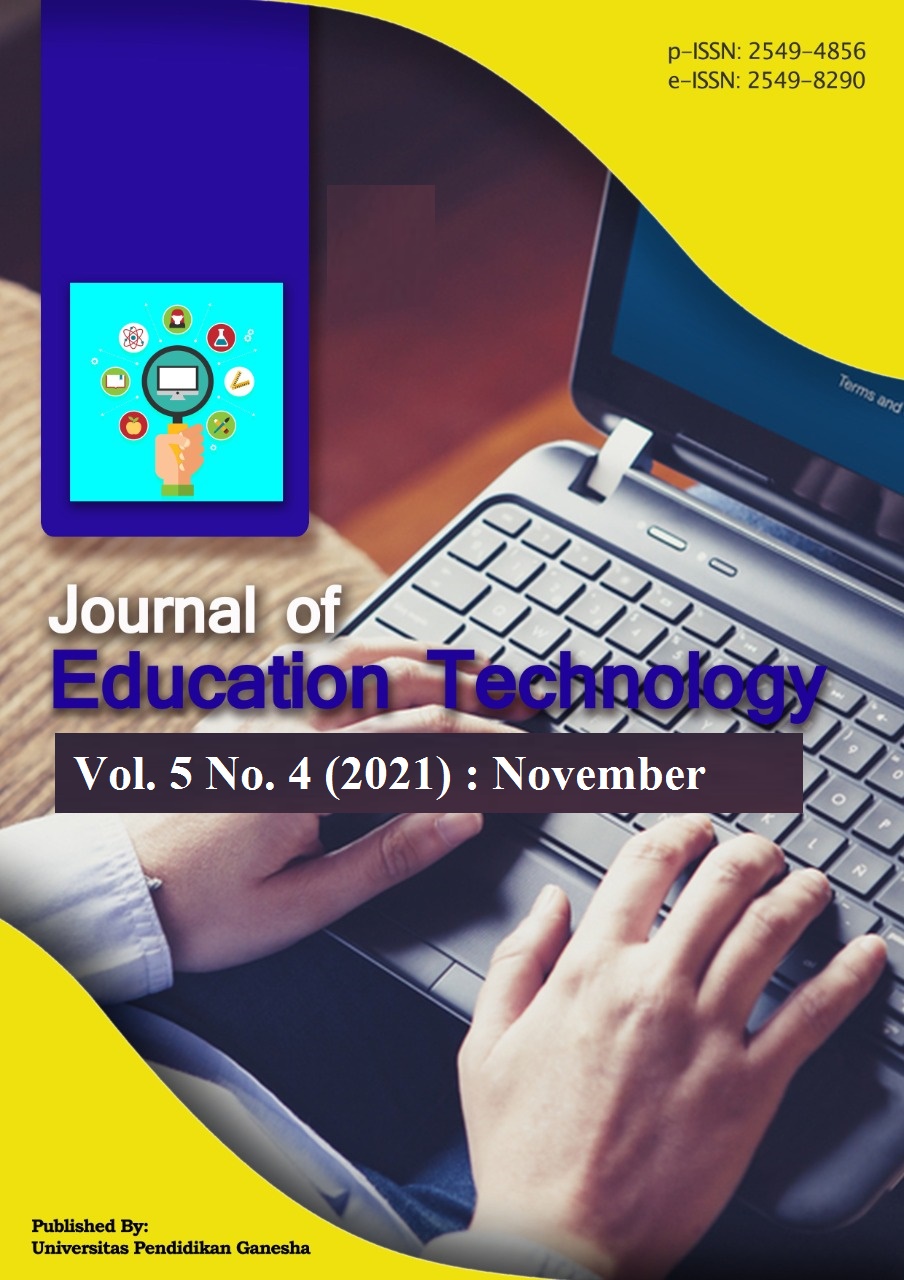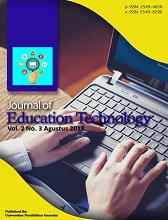Chassis Maintenance and Vehicle Power Transfer Learning: The Effectiveness of STEM on Students' Critical Thinking Ability
DOI:
https://doi.org/10.23887/jet.v5i4.40534Keywords:
STEM, Critical Thinking Ability, Chassis MaintenanceAbstract
The low critical thinking ability of students in the chassis maintenance and power transfer learning so that the required competencies are not achieved. This study aims to analyze critical thinking skills in chassis maintenance and power transfer learning which is taught using the Science, Technology, Engineering, and Mathematical (STEM) learning model and the conventional learning model. This research is a quasi-experimental type of research. The population in this study were students of class XI TKR 1 and XI TKR 2 as many as 69 students. Data collection techniques used documentation technique and test technique. The data analysis technique used descriptive analysis to know the category of students’ critical thinking skills and inferential analysis, including normality, homogeneity, and hypothesis by using a t-test to know the comparison of students’ critical thinking skills in learning chassis maintenance and power transfer which is taught using the Science, Technology, Engineering, And Mathematical (STEM) learning model and conventional learning models. This study shows that descriptive analysis obtained a Mean of 83.49 that was classified into a very high category and very effective category. The t-test proves the data. The tvalue value is 8045, and the ttable is df 67 = 2,000, so it can be decided that H0 is rejected. Ha is accepted because tvalue > ttable, so it can be concluded that the Science, Technology, Engineering, and Mathematical (STEM) learning model is effectively used to improve critical thinking skills compared to using conventional learning models.References
Adair, D., & Jaeger, M. (2016). Incorporating Critical Thinking into an Engineering Undergraduate Learning Environment. International Journal of Higher Education, 5(2). https://doi.org/10.5430/ijhe.v5n2p23.
Afriana, J., Permanasari, A., & Fitriani, A. (2016). Penerapan Project Based Learning Terintegrasi STEM untuk Meningkatkan Literasi Sains Siswa Ditinjau dari Gender. Jurnal Inovasi Pendidikan IPA, 2(2), 202. https://doi.org/10.21831/jipi.v2i2.8561.
Ahern, A., Dominguez, C., McNally, C., O’Sullivan, J. J., & Pedrosa, D. (2019). A literature review of critical thinking in engineering education. Studies in Higher Education, 44(5), 816–828. https://doi.org/10.1080/03075079.2019.1586325.
Alonzo, A. C. (2018). An Argument for Formative Assessment with Science Learning Progressions. Applied Measurement in Education, 31(2), 104–112. https://doi.org/10.1080/08957347.2017.1408630.
Amin, S., Utaya, S., Bachri, S., Sumarmi, & Susilo, S. (2020). Effect of Problem-Based Learning on Critical Thinking Skills and Environmental Attitude. Journal of Physics: Conference Series, 1810, (1), 1-5. https://doi.org/10.1088/1742-6596/1810/1/012060.
Balwant, P. T., & Doon, R. (2021). Alternatives to the Conventional ‘Oxford’ Tutorial Model: A Scoping Review. International Journal of Educational Technology in Higher Education (Vol. 18, Issue 1). https://doi.org/10.1186/s41239-021-00265-y.
Braun, H. I., Shavelson, R. J., Zlatkin-Troitschanskaia, O., & Borowiec, K. (2020). Performance Assessment of Critical Thinking: Conceptualization, Design, and Implementation. Frontiers in Education, 5. https://doi.org/10.3389/feduc.2020.0015.
Çelik, Ö., Çokçalışkan, H., & Yorulmaz, A. (2018). Investigation of the Effect of Pre-Service Classroom Teachers’ Critical Thinking Disposition on Their Media Literacy. International Journal of Evaluation and Research in Education (IJERE), 7(3), 194–202. http://doi.org/10.11591/ijere.v7i3.13960.
Cetrulo, A., & Nuvolari, A. (2019). Industry 4.0: Revolution or Hype? Reassessing Recent Technological Trends and Their Impact on Labour. Journal of Industrial and Business Economics, 46(3), 391–402. https://doi.org/10.1007/s40812-019-00132-y.
Cifrian, E., Andrés, A., Galán, B., & Viguri, J. R. (2020). Integration of Different Assessment Approaches: Application to a Project-Based Learning Engineering Course. Education for Chemical Engineers, 31, 62–75. https://doi.org/10.1016/j.ece.2020.04.006.
Conradty, C., & Bogner, F. X. (2020). STEAM Teaching Professional Development Works: Effects on Students’ Creativity and Motivation. Smart Learning Environments (Vol. 7, Issue 1). https://doi.org/10.1186/s40561-020-00132-9.
Dakabesi, D.-, & Luoise, I. S. Y. (2019). The Effect of Problem Based Learning Model on Critical Thinking Skills in the Context of Chemical Reaction Rate. Journal of Education and Learning (EduLearn), 13(3), 395–401. https://doi.org/10.11591/edulearn.v13i3.13887.
Daryono, R. W., Rochmadi, S., & Hidayat, N. (2021). Development and Validation of Video-Based Learning Media to Increase Competency Achievement in Civil Engineering Education. Journal of Physics: Conference Series, 1833(1), 012022. https://doi.org/10.1088/1742-6596/1833/1/012022.
Elizabeth L., & Adams. (2021). The Effect of a Middle Grades STEM Initiative on Students’ Cognitive and Non-Cognitive Outcomes. Studies in Educational Evaluation, 68(April 2020). https://doi.org/10.1016/j.stueduc.2021.100983.
Febrianti, R. A. M., Haizam Mohd Saudi, M., Kaniawati, K., & Hermina, N. (2018). Transformation of Digital Marketing in the 4.0 Industry Revolution: A Study on Batik MSMEs. International Journal of Engineering & Technology, 7(4.34), 352–357. https://doi.org/10.14419/ijet.v7i4.34.25779.
Fung, D. C.-L., & Liang, T. W. (2019). Fostering critical thinking through collaborative group work: Insights from Hong Kong. Springer Singapore. https://doi.org/10.1007/978-981-13-2411-6.
Gok, T. (2021). The Development of the STEM (Science, Technology, Engineering, and Mathematics) Attitude and Motivation Survey Towards Secondary School Students. International Journal of Cognitive Research in Science Engineering and Education, 9(1), 105–119. https://doi.org/10.23947/2334-8496-2021-9-1-105-119.
Hallström, J., & Schönborn, K. J. (2019). Models and Modelling for Authentic STEM Education: Reinforcing the Argument. International Journal of STEM Education (Vol. 6, Issue 1). https://doi.org/10.1186/s40594-019-0178-z.
Han, S., Yalvac, B., Capraro, M. M., & Capraro, R. M. (2015). In-service Teachers’ Implementation andUnderstanding of STEMProject Based Learning. EURASIA Journal of Mathematics, Science and Technology Education, 11(1), 63–76. https://doi.org/10.12973/eurasia.2015.1306a.
Isdianti, M., Nasrudin, H., & Erman, E. (2021). The effectiveness of STEM Based Inquiry Learning Packages to Improving Students’ Critical Thinking Skill. Journal for the Education of Gifted Young Scientists, 9(3), 223–232. https://doi.org/10.17478/jegys.832239.
Juano, A., & Pardjono, P. (2016). Pengaruh Pembelajaran Problem Posing terhadap Kemampuan Berpikir Kritis dan Komunikasi Matematis Siswa Kelas V SD. Jurnal Prima Edukasia, 4(1), 46. https://doi.org/10.21831/jpe.v4i1.7801.
Khan, Z., Soundararajan, V., & Shoham, A. (2020). Global Post-Merger Agility, Transactive Memory Systems and Human Resource Management Practices. Human Resource Management Review, 30(1), 1–10. https://doi.org/10.1016/j.hrmr.2019.100697.
Kleemola, K., Hyytinen, H., & Toom, A. (2021). Exploring Internal Structure of a Performance-Based Critical Thinking Assessment for New Students in Higher Education. Assessment and Evaluation in Higher Education. https://doi.org/10.1080/02602938.2021.1946482.
Kolesnichenko, E. A., Radyukova, Y. Y., & Pakhomov, N. N. (2019). The Role and Importance of Knowledge Economy as a Platform for Formation of Industry 4.0. In E. G. Popkova, Y. V. Ragulina, & A. V. Bogoviz (Eds.), Industry 4.0: Industrial Revolution of the 21st Century (Vol. 169, pp. 73–82). Springer International Publishing. https://doi.org/10.1007/978-3-319-94310-7_7.
Kusuma, W. M., Sudira, P., Hasibuan, M. A., & Daryono, R. W. (2021). The Perceptions of Vocational School Students of Video Animation-Based Learning Media to Operate Lathes in Distance Learning. Journal of Education Technology, 5(2), 200. https://doi.org/10.23887/jet.v5i2.33139.
Lavi, R., Tal, M., & Dori, Y. J. (2021). Perceptions of STEM Alumni and Students on Developing 21st Century skills Through Methods of Teaching and Learning. Studies in Educational Evaluation, 70. https://doi.org/10.1016/j.stueduc.2021.101002.
Liang, W., & Fung, D. (2020). Development and Evaluation of a WebQuest-Based Teaching Programme: Students’ Use of Exploratory Talk to Exercise Critical Thinking. International Journal of Educational Research, 104(August), 1–13. https://doi.org/10.1016/j.ijer.2020.101652.
Liu, X., Chen, Y., Yang, Y., Liu, B., Ma, C., Craig, G. R., & Gao, F. (2020). Understanding Vocational Accounting Students’ Attitudes Towards Sustainable Development. Journal of Vocational Education & Training, 1–21. https://doi.org/10.1080/13636820.2020.1760333.
Mikhaylovsky, M. N., Karavanova, L. Zh., Medved, E. I., Deberdeeva, N. А., Buzinova, L. M., & Zaychenko, A. A. (2021). The Model of STEM Education as an Innovative Technology in the System of Higher Professional Education of the Russian Federation. Eurasia Journal of Mathematics, Science and Technology Education, 17(9), em2007. https://doi.org/10.29333/ejmste/11173.
Nurnia, N., & Tasina, H. A. (2020). Critical Thinking of Field Independent Students; which Model of Teaching is more Supportive? JTP - Jurnal Teknologi Pendidikan, 22(2), 108–116. https://doi.org/10.21009/jtp.v22i2.16018.
Patacsil, F., & S. Tablatin, C. L. (2017). Exploring the Importance of Soft and Hard Skills as Perceived by IT Internship Students and Industry: A Gap Analysis. Journal of Technology and Science Education, 7(3), 347–368. https://doi.org/10.3926/jotse.271.
Rahayu, M. S. I., & Kuswanto, H. (2021). The Effectiveness of the Use of the Android-Based Carom Games Comic Integrated to Discovery Learning in Improving Critical Thinking and Mathematical Representation Abilities. Journal of Technology and Science Education, 11(2), 270. https://doi.org/10.3926/jotse.1151.
Saifurrahman, M., Sudira, P., & Daryono, R. W. (2021). The Determinant Factor of the Principal Leadership Solutions in Facing the 21st-Century Learning. Jurnal Pendidikan dan Pengajaran, 54(2), 230-243. http://dx.doi.org/10.23887/jpp.v54i2.34102.
Seibert, S. A. (2021). Problem-Based Learning: A Strategy to Foster Generation Z’s Critical Thinking and Perseverance. Teaching and Learning in Nursing, 16(1), 85–88. https://doi.org/10.1016/j.teln.2020.09.002.
Setyadi, M. R. A., Triyono, M. B., & Daryono, R. W. (2021). The Influence of Industrial Work Practices and Workshop Infrastructure Facilities on Work Readiness of Students. Journal of Physics: Conference Series, 1833(1), 1–8. https://doi.org/10.1088/1742-6596/1833/1/012029.
Shavelson, R. J., Zlatkin-Troitschanskaia, O., Beck, K., Schmidt, S., & Marino, J. P. (2019). Assessment of University Students’ Critical Thinking: Next Generation Performance Assessment. International Journal of Testing, 19(4), 337–362. https://doi.org/10.1080/15305058.2018.1543309.
Sleeman, J., Lang, C., & Dakich, E. (2019). Social Media, Learning and Connections for International Students: The Disconnect Between what Students Use and the Tools Learning Management Systems Offer. Australasian Journal of Educational Technology, 36(4), 44–56. https://doi.org/10.14742/ajet.4384.
Stehle, S. M., & Peters-Burton, E. E. (2019). Developing Student 21st Century Skills in Selected Exemplary Inclusive STEM High Schools. International Journal of STEM Education (Vol. 6, Issue 1). https://doi.org/10.1186/s40594-019-0192-1.
Supriyadi, E., Indro H., Y., Priyanto, E., & Surwi, F. (2020). Students’ Evaluation on Teaching in Vocational and Technical Schools. International Journal of Instruction, 13(2), 621–636. https://doi.org/10.29333/iji.2020.13242a.
Susanti, V. D., & Krisdiana, I. (2021). The Effect of Literacy Skills on the Critical Thinking Skills of Mathematics Education Students. AL-ISHLAH: Jurnal Pendidikan, 13(1), 72–79. https://doi.org/10.35445/alishlah.v13i1.371.
Suwanroj, T., Leekitchwatana, P., & Pimdee, P. (2019). Confirmatory Factor Analysis of the Essential Digital Competencies for Undergraduate Students in Thai Higher Education Institutions. Journal of Technology and Science Education, 9(3), 340. https://doi.org/10.3926/jotse.645.
Vossen, T. E., Tigelaar, E. H., Henze, I., De Vries, M. J., & Van Driel, J. H. (2020). Student and Teacher Perceptions of the Functions of Research in the Context of a Design-Oriented STEM Module. International Journal of Technology and Design Education, 30(4), 657–686. https://doi.org/10.1007/s10798-019-09523-7.
Downloads
Published
How to Cite
Issue
Section
License
Authors who publish with the Journal of Education Technology agree to the following terms:
- Authors retain copyright and grant the journal the right of first publication with the work simultaneously licensed under a Creative Commons Attribution License (CC BY-SA 4.0) that allows others to share the work with an acknowledgment of the work's authorship and initial publication in this journal.
- Authors are able to enter into separate, additional contractual arrangements for the non-exclusive distribution of the journal's published version of the work (e.g., post it to an institutional repository or publish it in a book), with an acknowledgment of its initial publication in this journal.
- Authors are permitted and encouraged to post their work online (e.g., in institutional repositories or on their website) prior to and during the submission process, as it can lead to productive exchanges, as well as earlier and greater citation of published work. (See The Effect of Open Access)


















